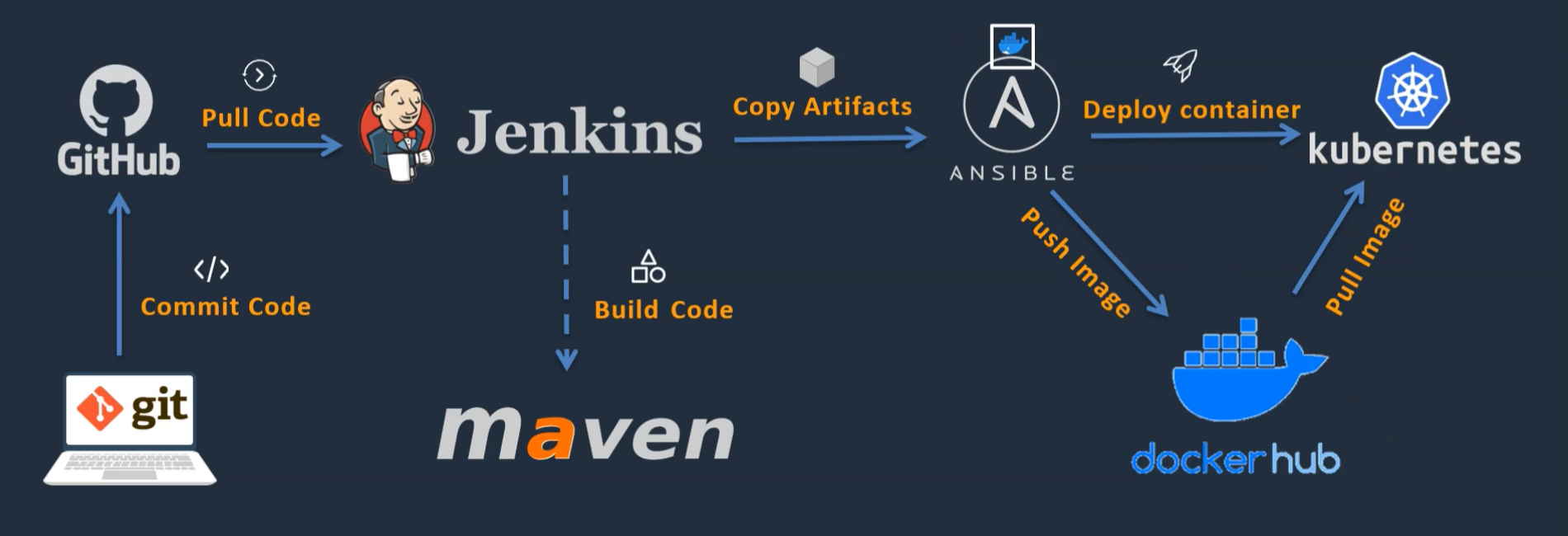Architecture Flow
- CI : User → Commit code to GitHub(SCM) → Jenkins Build Artifacts using Maven Plugin(Build) → Artifacts Deployed to Ansible Server
- CD : Ansible Server Builds Docker Image → Push Image to Docker Hub → Deploy app to Azure Kubernetes Service
Tools Used:
- GitHub: Source Code Management and Versioning GitHub Repository
- Jenkins: For orchestrating the CI/CD Pipeline
- Maven: To build Artifacts
- Docker: Containerize the Application using Dockerfile
- Ansible: To automate deployment using ansible-playbooks
- DockerHub: Versioning Docker images, centralized image repository.
- Azure Kubernetes Service: Container orchestration
Demo Video
Demo video:
Will be published on 08.02.2025
Step-by-Step Implementation
1. Setup GitHub Repository
- Create a repository on GitHub and push the Spring Boot application code.
- Ensure it contains a
DockerfileandJenkinsfile.
2. Install and Configure Jenkins
Install Jenkins on a Server
sudo apt update
sudo apt install openjdk-11-jdk -y
wget -q -O - https://pkg.jenkins.io/debian/jenkins.io.key | sudo apt-key add -
sudo sh -c 'echo deb http://pkg.jenkins.io/debian-stable binary/ > /etc/apt/sources.list.d/jenkins.list'
sudo apt update
sudo apt install jenkins -y
sudo systemctl start jenkins
sudo systemctl enable jenkins
Install Required Plugins
- GitHub Plugin
- Publish Over SSH
- Maven Integration
3. Configure Jenkins Pipeline (CI)
Jenkinsfile
pipeline {
agent any
environment {
DOCKER_CREDENTIALS_ID = 'docker-hub-credentials'
}
stages {
stage('Clone Repository') {
steps {
git branch: 'main', url: 'https://github.com/your-repo.git'
}
}
stage('Build with Maven') {
steps {
sh 'mvn clean package'
}
}
stage('Archive Artifact') {
steps {
archiveArtifacts artifacts: 'target/*.jar', fingerprint: true
}
}
stage('Deploy to Ansible Server') {
steps {
sh 'scp target/*.jar ansible@your-ansible-server:/opt/artifacts/'
}
}
}
}
4. Configure Ansible for Deployment (CD)
Install Ansible on the Deployment Server
sudo apt update
sudo apt install ansible -y
Ansible Playbook: **deploy.yml**
- name: Deploy Dockerized Spring Boot App
hosts: all
become: true
tasks:
- name: Build Docker Image
command: docker build -t your-dockerhub-username/app:latest .
- name: Push Docker Image to Docker Hub
command: docker push your-dockerhub-username/app:latest
- name: Deploy to Kubernetes
command: kubectl apply -f deployment.yaml
5. Create Kubernetes Deployment Configuration
**deployment.yaml**
apiVersion: apps/v1
kind: Deployment
metadata:
name: springboot-app
spec:
replicas: 2
selector:
matchLabels:
app: springboot-app
template:
metadata:
labels:
app: springboot-app
spec:
containers:
- name: springboot-app
image: your-dockerhub-username/app:latest
ports:
- containerPort: 8080
---
apiVersion: v1
kind: Service
metadata:
name: springboot-service
spec:
type: LoadBalancer
ports:
- port: 80
targetPort: 8080
selector:
app: springboot-app
6. Configure Azure Kubernetes Service (AKS)
Install Azure CLI and Set Up AKS
az login
az group create --name myResourceGroup --location eastus
az aks create --resource-group myResourceGroup --name myAKSCluster --node-count 2 --enable-addons monitoring --kubernetes-version 1.29.2 --generate-ssh-keys
az aks get-credentials --resource-group myResourceGroup --name myAKSCluster
Deploy Application to AKS
kubectl apply -f deployment.yaml
kubectl get services
7. Automate CI/CD with Jenkins
-
Add a webhook in GitHub to trigger the Jenkins build on code commit.
-
Configure Jenkins to trigger Ansible playbooks after successful builds.
8. Verify Deployment
- Check running pods:
kubectl get pods - Get service external IP:
kubectl get services - Access the application using the external IP in the browser.

